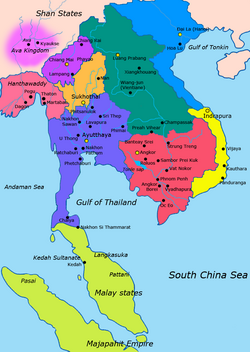
Back مملكة هنثوادي Arabic Hanthawaddy Czech Pegu (Reich) German Βασίλειο Χανθαγουάντι Greek پادشاهی هانتاوادی Persian Royaume d'Hanthawaddy French Kerajaan Hanthawaddy ID Regno di Hanthawaddy Italian ペグー王朝 Japanese នគរហង្សាវត្តី Cambodian
Hanthawaddy Kingdom Hongsarwatoi Kingdom | |||||||||
|---|---|---|---|---|---|---|---|---|---|
| 1287–1552 | |||||||||
 Hanthawaddy in red in the northwest, c. 1450 | |||||||||
| Status | Kingdom | ||||||||
| Capital | Martaban (1287–1364) Donwun (1364–1369) Pegu (1369–1538, 1550–1552) | ||||||||
| Common languages | Mon Old Burmese | ||||||||
| Religion | Theravada Buddhism | ||||||||
| Government | Monarchy | ||||||||
• 1287–1307 | Wareru | ||||||||
• 1384–1421 | Razadarit | ||||||||
• 1454–1471 | Shin Sawbu | ||||||||
• 1471–1492 | Dhammazedi | ||||||||
• 1492–1526 | Binnya Ran II | ||||||||
| Historical era | Warring states | ||||||||
• Overthrow of Pagan governor | c. January 1285 | ||||||||
• Independence from Pagan | 30 January 1287 | ||||||||
• Vassal of Sukhothai | 1287–1298, 1307–1317, 1330 | ||||||||
| 1385–1424 | |||||||||
• Golden Age | 1426–1534 | ||||||||
| 1534–1541 | |||||||||
• 2nd Fall of Pegu | 12 March 1552 | ||||||||
| |||||||||
| Today part of | Myanmar Thailand | ||||||||
The Hanthawaddy Kingdom (Mon: ဍုၚ် ဟံသာဝတဳ, [hɔŋsawətɔe]ⓘ; Burmese: ဟံသာဝတီ နေပြည်တော်; also Rone Hongsarwatoi or simply Pegu) was the polity that ruled lower Burma (Myanmar) from 1287 to 1539 and from 1550 to 1552. The Mon-speaking kingdom was founded as Ramaññadesa (Mon: ရးမည, Burmese: ရာမည ဒေသ) by King Wareru following the collapse of the Pagan Kingdom in 1287[1]: 205–206, 209 as a nominal vassal state of the Sukhothai Kingdom and of the Mongol Yuan dynasty.[2] The kingdom became formally independent of Sukhothai in 1330 but remained a loose federation of three major regional power centres: the Irrawaddy Delta, Bago, and Mottama. Its kings had little or no authority over the vassals. Mottama was in open rebellion from 1363 to 1388.
- ^ Coedès, George (1968). Walter F. Vella (ed.). The Indianized States of Southeast Asia. trans.Susan Brown Cowing. University of Hawaii Press. ISBN 978-0-8248-0368-1.
- ^ Htin Aung 1967: 78–80
